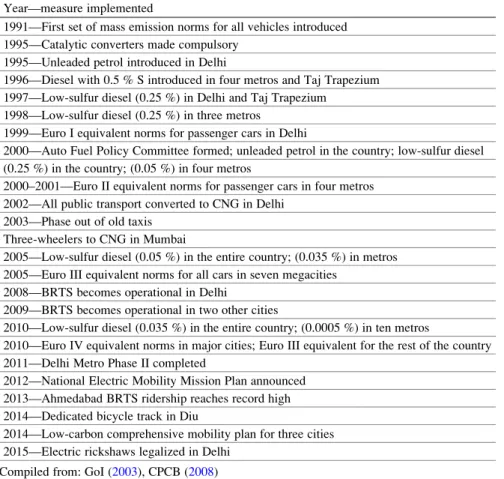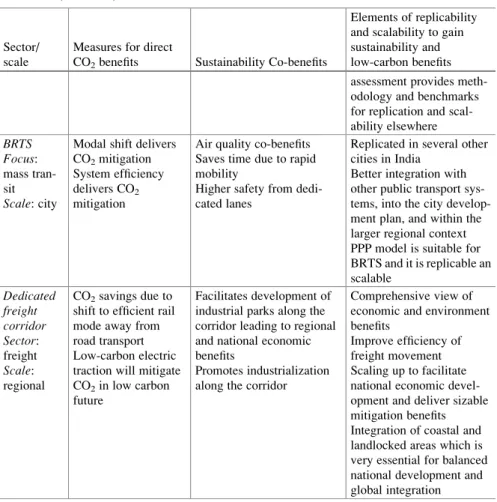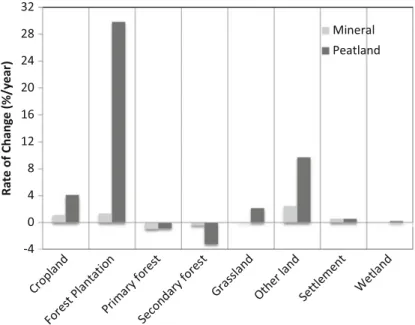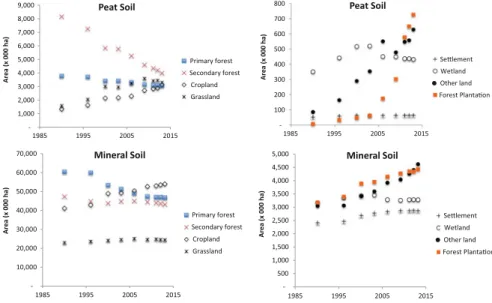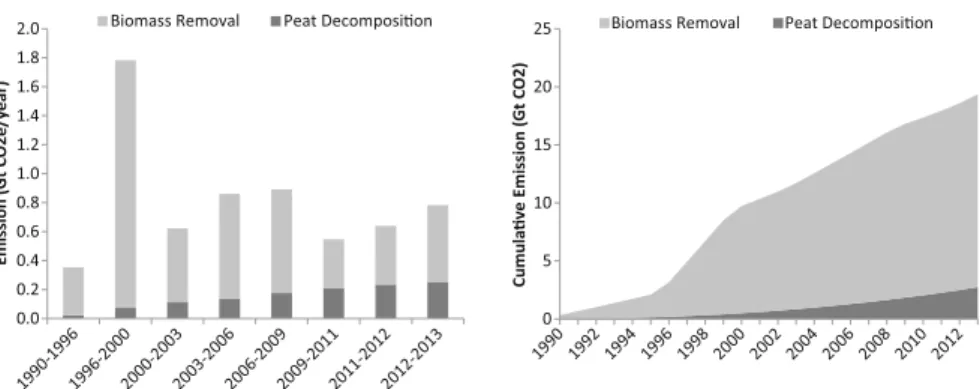India's transport sector is a fast growing sector and contributes 6.4% to the country's GDP. For example, India's National Action Plan on Climate Change (NAPCC) emphasizes a mix of measures, including higher share of public transport, penetration of biofuels and significant improvements in vehicle efficiency (GoI2008).
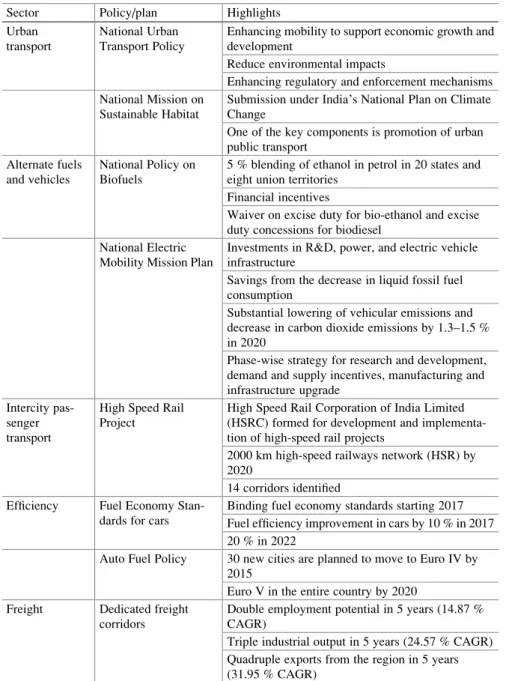
Case 2: Auto Fuel Policy (AFP)
When the Auto Fuel Policy Committee was formed in 2000, its focus was on addressing air quality issues in the country. Joint reduction of local pollutants and greenhouse gas emissions could be considered in the Auto Fuel Policy Roadmap 2025.
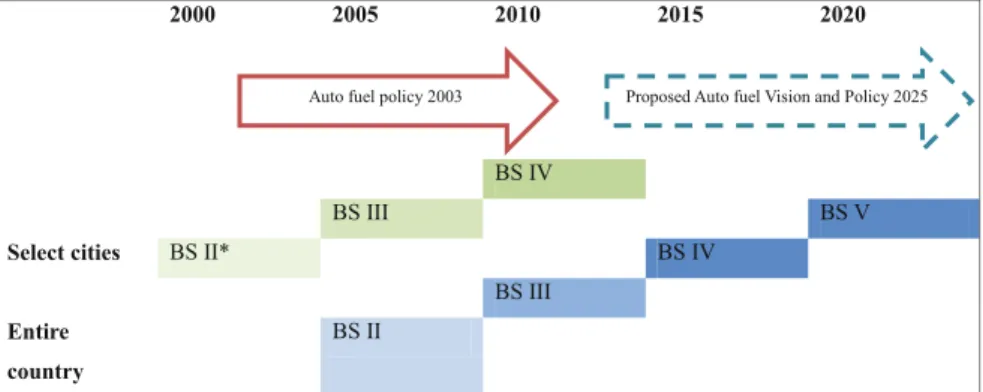
Bus Rapid Transit System
The clear vision, implementation process and success of the AFP 2003 helped replicate and scale up the Auto Fuel Policy Vision 2025. Key challenges include the lack of ownership of the system by the planning and implementing agencies, the reluctance of private vehicle owners to share roads. space, and insufficient clarity in implementation (Mahadevia et al.2013a).
Low-Carbon Comprehensive Mobility Plan Toolkit
Inclusiveness will depend on understanding users' mobility needs and capacities and integrating them into the plan. Planning of BRTS projects should be based on a comprehensive assessment to include all sections of the population, their travel patterns and mode choices based on age, gender and economic status.
Dedicated Freight Corridor (DFC)
This will create a common and comparable database of cities' traffic indicators, which will further facilitate adoption in many cities, especially smaller ones. In addition, the robust methodology will enable cities to develop funding proposals, including international climate finance.
National Electric Mobility Mission Plan
Increasing EV penetration in India and making these vehicles competitive against conventional vehicles will require financial incentives for electric vehicles, improved charging infrastructure and other local incentives (Shukla et al.2014). EVs will require upfront investment; however, the savings from reduced diesel demand as a result of switching to electric propulsion will far outweigh the support provided, making this economically viable.
Conclusion
Elements of replicability and scalability to achieve sustainability and low-carbon benefits Policy-related case studies. 11, UNEP Riso Centre, Denmark Technical University, Denmark Pangotra P, Shukla PR (2012) Infrastructure for low carbon transport in India: a case study of the.
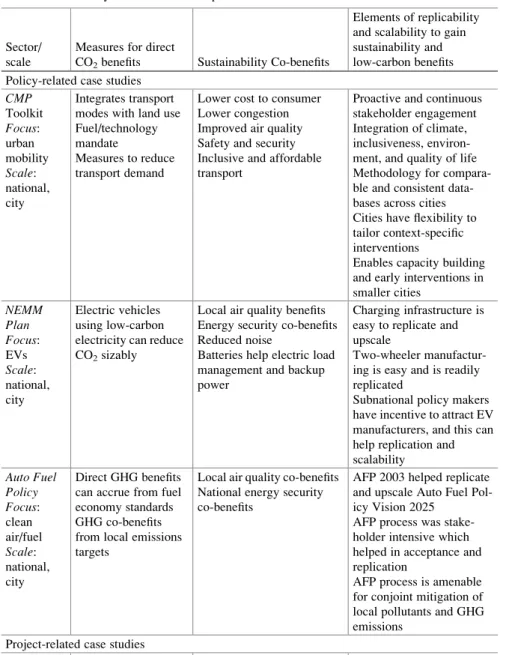
Introduction
The three tropical regions, South America (TSAm), Southeast Asia (SEA) and tropical Africa (Af), are the main contributors to global emissions from land use change and forestry (Fig.9.1). GHG emission from land use change and forest (LUCF) is found to be the main contributor to the total national emission.
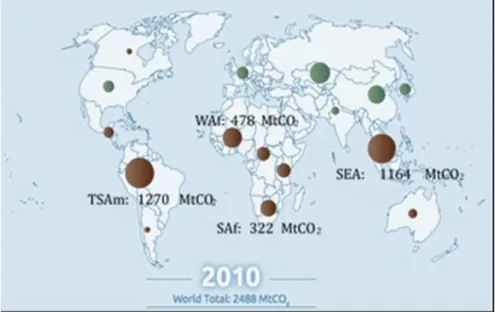
Indonesian Forest
Deforestation and Trend of CO2 Emission
Data show that about half of the conversion of forest to non-forest land ends up as grassland (including scrub). The rate of forest loss in peatlands is relatively higher than in mineral soils (Figure 9.5).
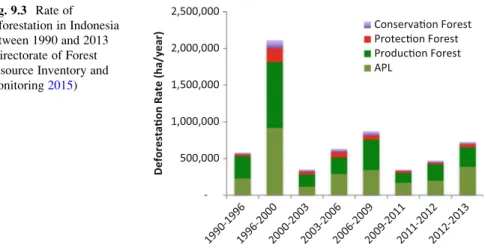
Low-Carbon Policies on Forest and Land Use Sector
- Forest Management Units (FMUs)
- Forest Certification System
- Reduction of Dependency on Natural Forests for Wood Supply and Sink Enhancement
- Reduction of Pressure on Natural Forest by Optimizing Land Use and Improving Land Productivity
Many land and forest rehabilitation investments carried out in the forest area (GERHAN) often fail due to the absence of an on-site manager to take care of the maintenance of the planted trees. The upper limit could be determined based on the results of an environmental impact assessment (EIA). Optimizing the use of non-forest areas for agricultural activities by changing the function of the forest.
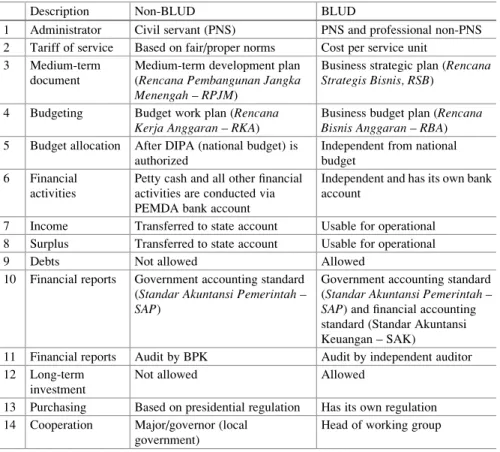
Financing and Incentive Policies for Supporting the Implementation of SFM and REDD+
- Financial Policy for Development of FMUs
- Incentive System for Certification
- Incentive and Financial Policy for Accelerating the Establishment of Timber Plantation on Degraded
- Incentive and Financial Policies for Conserving Forest Carbon and Land Swap
Accelerating the ecosystem restoration program, which will make a significant contribution to drainage improvement, also requires incentive from the government. To reduce costs, the process of developing the forest boundary could be integrated with the development of the FMU and carried out through participatory mapping process. As decided by the Conference of the Parties (COP), payment from the implementation of REDD+ activities will be performance-based payment.
Capacity Development Is Important in Asia—A Tool for Leapfrog
- The Power of Asia
- The Rise of ASEAN
- Regional Development
- Decoupling of GHG and GDP
- How Can Asia Leapfrog to a Low-Carbon Society?
High energy consumption was found to be associated with the Human Development Index, as shown in Figure 10.3. Decoupling CO2 emissions from GDP growth is one of the indicators showing that the development path must take into account low-carbon technologies and activities (see Figure 10.5). The implication of this figure is shown in Table 10.1, where the GDP of ASEAN, especially the four countries in Asia (China, India, Japan and South Korea) will account for 38% of global GDP in the next 15 years (up to 2030), which from 2010 increased by almost 10%.
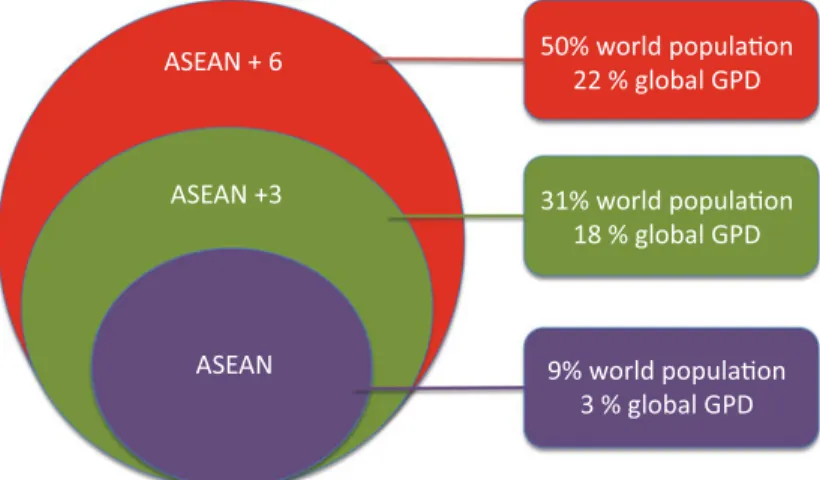
Structure and Mechanisms of Capacity Development
Knowledge-Sharing Platform
In Asia, this society is mainly low-income to middle-income communities and they are the majority of the Asian population. This society is key to fostering capacity development in this region through knowledge management. However, the main issue of this society is to connect with other levels of society to spread the knowledge to the real implementers.
From Research to Policy and Implementation
Asian countries need to have a knowledge sharing platform to circulate information at different levels of society so that all will understand the same goal and rationale for each policy and measure to be implemented and implemented. Institutional arrangements that cover the entire research-to-policy-implementation loop can connect the various actions of the above-mentioned organizations for the effective implementation of low-carbon activity. Any committee appointed to deal with low-carbon development should include three people, namely research, policy and implementation, to push all measures to full implementation.
Level of Low-Carbon Society Implementation
Ban Pred Nai is a small community located in the coastal area of Trang Province in the eastern part of Thailand. This indicated good understanding of self-sufficient life with self-development by the people of Ban Pred Nai. The activities in the low-carbon city of Muang Klang Municipality in Rayong Province in Thailand are a good example of knowledge transfer from research to policy and to implementation.
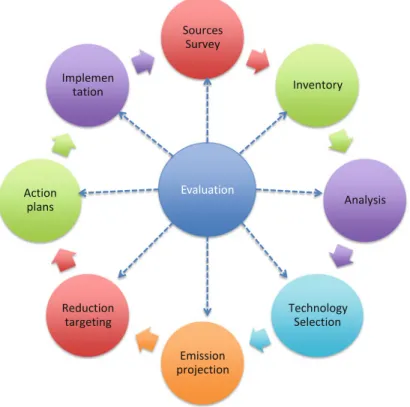
Mechanism of Knowledge Dissemination
The primary goal of the SEE Forum is to seek academic, scientific and technological collaboration that will contribute to solving global climate and energy security challenges (Sustainable Energy and Environmental Forum, 2015). The link with the Asia University Network (AUN) and joint research supported by the SATREP program are some of the products of this forum. Human resource development A leap towards a low-carbon society requires insight into the real situation and problems in the region.
Conclusion and Key Messages
Capacity Development Is the Basis for Asia ’ s Leapfrog
Due to the constraints of the energy crisis and the impact of climate change, Asia's future growth, although it seems the most important compared to other regions, needs a good knowledge-based path to illuminate and pave the way to a low-carbon society. Capacity development is a basic need and urgent issue to be explored in Asia. It is one of the effective tools for Asia to leap into a low-carbon society by taking care of the unlocked development of carbon intensity.
A Bullet Train Model
Asian Countries Need Collaboration
Joint Graduate School of Energy and Environment, KMUTT (2011) A study submitted to the Thailand Greenhouse Gas Management Office. The workshop is tasked with improving the credibility of greenhouse gas inventory datasets in Asia and helping to link countries in the Asian region. Establishment of the WGIA network platform to exchange information on climate change and greenhouse gas emissions mitigation and greenhouse gas inventory.
Introduction to WGIA
- GHG Inventory in International Negotiations
- Responsibility of Developing Countries
- The Role of Greenhouse Gas Inventory Office of Japan (GIO)
- One Part of the National System
- The Objective of WGIA
- History of WGIA
- Contents of WGIA
- Latest Workshop on GHG Inventories in Asia (WGIA12), 2014
Its mission is to compile Japan's annual national greenhouse gas (GHG) inventory; carrying out various tasks and activities related to the greenhouse gas inventory, such as providing support and assistance for the technical assessment of Japan's national greenhouse gas inventory for the UNFCCC and the Kyoto Protocol; and to contribute to the capacity building of Asian countries in developing and improving their greenhouse gas inventories (see Table 11.2). Participants welcome this presentation as a cross-cutting issue such as QA/QC; The consistency of UA and time series that are important for improving the quality of the greenhouse gas inventory are discussed. The Ministry of Environment of Japan (MoEJ) and the National Institute for Environmental Studies (NIES) convened the WGIA as a capacity-building workshop for measurability, reportability and verifiability (MRV) as part of Japan's assistance to developing countries.
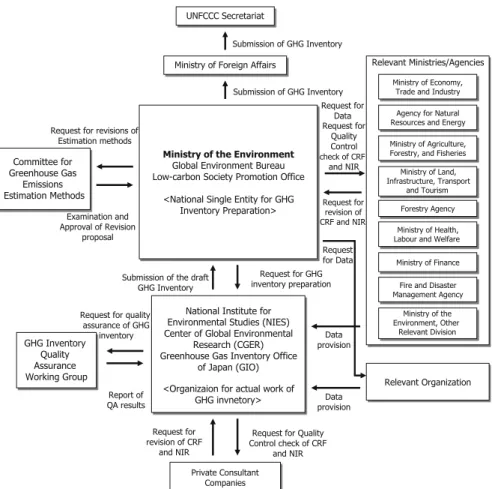
Achievements of WGIA .1 Enhanced Relationships
- Sharing Information Such as Sector-Specific Issues and General Issues of GHG Inventory
- Related Activities and International Cooperation
- Networks
- Achievements
Correa also mentioned that peer learning is implemented as a form of external quality assurance in WGIA sessions. The idea and importance of mutual learning to improve the quality of the GHG inventory originated in the WGIA. The function of GHG emissions forecasts is one of the main benefits of the GHG inventory; thus, the AIM team is invited to the WGIA every year.
Other activities of WGIA .1 Website and Mailing List
WGIA-EFDB (Emission Factors Database)
Malaysia, Cambodia and Indonesia stated that a continuous database of emission factors for greenhouse gas inventory was needed. Since WGIA7, GIO has collected a number of articles presenting country-specific emission factors developed for different sectors. These values should be integrated into the emission factor database (EFDB) being developed for the region.
Conclusions
- Importance of Ongoing, Face-to-Face Discussions
- Sharing of Information and Experience
- Network Utilisation
- Continuity of WGIA
Ministry of Environment, Japan and Greenhouse Gas Inventory Office of Japan (GIO), CGER, NIES (2014), National Inventory report of Japan, April 2014. The uniform reduction policy of the central governments of each country is the core of the reduction policy implementation. It is here that the results of a series of scientific cooperation projects promoted in the Asian region by the Government of Japan, in particular the Japanese Ministry of Environment, can be fully appreciated.
Japan ’ s Strategies to Support Scientific Climate Policymaking in Asia
Scope of Scientific Climate Policy
This represents a major transition challenge for developed countries, which are based on, and at the same time struggle to be free from the inclusion of highly energy-consuming technologies, as they will have to renovate their social infrastructure to one based on a low-carbon society. Based on economic growth rates and demographics, the necessary amount of services per sector for continuation of conventional policy (BaU: Business as Usual) and the energy required to make these services possible are calculated. The resulting investment costs in the necessary infrastructure based on the overall reduction plan can be estimated (see Fig.12.2, top right).
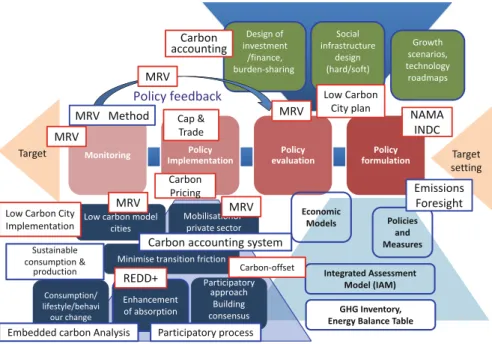
Japan ’ s Support for Climate Policies in Asia
The network's annual meetings, which began in 2012, include discussions on key research topics for low-carbon development. To become an independent leading network for low-carbon policy research in Asia, the formation of a CoE (center of Excellence) alliance is underway. Developing human resources for the formation of low-carbon policies Since the 1980s, the Ministry of Environment of Japan, in cooperation with the Japan International Cooperation Agency (JICA), has focused its efforts on developing human resources to support environmental research and environmental policy. Asia.
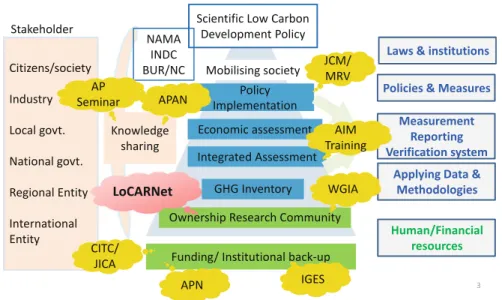
The Low Carbon Asia Research Network (LoCARNet)
Science-Based Policy Formulation: LoCARNet Research and Policy Integration Activities
All countries in the Asian region are currently working on plans to achieve low-carbon development. The ultimate goal of LoCARNet is to promote regional cooperation to facilitate the formulation and implementation of evidence-based policies for low-carbon growth in the Asian region, together with relevant stakeholders. Starting in 2009, Japan's Ministry of the Environment and the National Institute for Environmental Studies began a research program on low-carbon development in Asia.
Future Plan
Asia has the potential for a low-carbon transition sufficient to contribute to the goal of stabilizing the temperature at two degrees. Continuous technological and institutional innovation is needed to support the transition to a sustainable low-carbon society. Asia is ready for a low-carbon transition and is waiting for signals from the Paris Agreement on climate change to implement climate stabilization measures.
